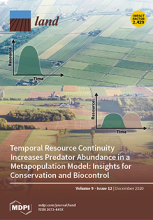/ library resources
Showing items 1 through 9 of 25.Since the Second World War, Poland has been undergoing an intensive process of transformation of the economic structure of rural areas, manifested, among other things, in the change in the occupational make-up of its inhabitants.
Sustainable development is socioeconomic growth that integrates political, economic, and social measures alongside environmental protection to meet the needs of communities and citizens without compromising the ability of future generations to meet their needs.
In many countries of the world, rural areas are characterized by a defective spatial structure of agricultural land. The most frequent defects are large fragmentation and distribution of farmland. The fragmentation of land has been an issue widely described by many authors throughout the world.
This paper determines the extent to which rural areas in Poland have been beneficiaries of the EU’s Cohesion Policy (CP). The amount of funds allocated to rural areas at the local (gmina/commune) level as part of the total CP obtained by Poland from 2007 to 2018 was estimated.
Modern agriculture development possibilities are highly dependent on many factors, including those which are related to the parameters of land spatial structure (including parcels fragmentation and parameters related to their shape).
The paper addresses the issue of dissatisfaction related to spatial management in rural areas illustrated with an example of southern Poland. In this region, the spatial structure of rural areas is poor, which results, e.g., from substantial fragmentation and scattering of land.
Land consolidation is an implement, which allows the rearrangement of spatial structure in rural areas leading to their socioeconomic development. However, the process is costly and time consuming.
In Poland land consolidation is carried out mainly in the southern part of the country. In three voivodships, namely Lubelskie Voivodship, Podkarpackie Voivodship and Małopolskie Voivodship, in the years 2003-2014 there were numerous land consolidations, over 20,000 ha in each voivodship.
Consolidation and post-consolidation development-related investments are an opportunity to improve living and working conditions of rural residents. Land consolidation is practically the only comprehensive tool to improve the shape of the transport network in the areas covered by this process.
Pagination
Land Library Search
Through our robust search engine, you can search for any item of the over 73,000 highly curated resources in the Land Library.
If you would like to find an overview of what is possible, feel free to peruse the Search Guide.



